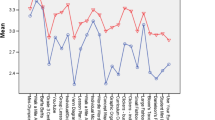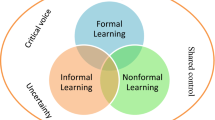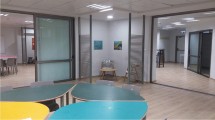Abstract
The purpose of this study is to examine the manner in which the features of a constructivist learning environment, and the mechanisms at its base, are expressed in junior high school students’ conceptions. Our research is based on an integration of quantitative and qualitative approaches, deigned to provide a wider ranging and deeper understanding. Eight hundred and forty eighth- and ninth-grade students from over 15 schools participated in the study. Of the 840 students who completed the questionnaire, the explanations of 200 well-written questionnaires were further analyzed qualitatively. The findings of the study are presented in terms of the four scales employed in the CLES, namely the autonomy scale, the prior knowledge scale, the negotiation scale, and the student-centeredness scale. The quantitative results achieved here concur with parallel studies conducted around the world. The findings indicate that a considerable portion of the students perceive their learning environment as a constructivist one and report positive attitudes toward the way they are being taught. In terms of the qualitative results, however, it appears that in some cases, the students’ explanations reveal that in fact, and contrary to the bare quantitative results, some students do not perceive their learning environment as being constructivist. This raises the question of whether the fact that students recognize the factors associated with constructivist teaching is indeed an indication that such teaching exists in practice. This finding emphasizes the importance of combining qualitative and quantitative methods for arriving at a balanced view of classroom occurrences.

Similar content being viewed by others
References
Aldrich J (1995) Correlations Genuine and Spurious in Pearson and Yule. Stat Sci 10:364–376
Ausubel DP (1968) Educational psychology: a cognitive view. Holt, Rinehart & Winston, New York
Ben-Zvi Assaraf O, Orpaz I (2009) The development of junior high school students’ understanding of earth systems and the human role as a learning outcome of the “life at the poles” study unit. Res Sci Educ 40(4):525–549
Boddy N, Watson K, Aubusson P (2003) A trial of the five Es: a referent model for constructivist teaching and learning. Res Sci Educ 33(1):27–42
Corbin J, Strauss A (1990) Grounded theory research: procedures, canons, and evaluative criteria. Qual Sociol 13(1):3–21
Creswell JW, Tashakkori A ( 2007) Editorial: differing perspective on mixed methods research. J Mixed Method Res 1:303–308
Cronbach LJ (1951) Coefficient alpha and the internal structure of tests. Psychometrika 16:297–334
Cronbach LJ, Shavelson RJ (2004) My current thoughts on coefficient alpha and successor procedures. Educ Psychol Measur 64:391–418
Duffy TM, Jonassen DH (1992) Constructivism and the technology of instruction: a conversation. Erlbaum, Hillsdale
Eshach H, Dor-Ziderman Y, Arbel Y (2011) Scaffolding the “scaffolding” metaphor: from inspiration to a practical tool for kindergarten teachers. J Sci Educ Technol. doi:10.1007/s10956-011-9323-2
Fraser BJ (1998) Classroom environment instruments: development, validity and applications. Learning Environ Res 1:7–33
Gijbels D, van de Watering G, Dochy F, van den Bossche P (2006) New learning environments and constructivism: the students’ perspective. Instr Sci 34(3):213–226
Gijbels D, Segers M, Struyf E (2008) Constructivist learning environments and the (im) possibility to change students’ perceptions of assessment demands and approaches to learning. Instr Sci 36(5–6):431–443
Glynn SM, Taasoobshirazi G, Brickman P (2009) Science motivation questionnaire: construct validation with nonscience majors. J Res Sci Teaching 46(2):127–146
Greeno JG, Collins AM, Resnick LB (1996) Cognition and learning. In: Berliner DC, Calfee RC (eds) Handbook of educational psychology. Simon & Schuster Macmillan, New York, pp 15–46
Harris KR, Alexander PA (1998) Integrated, constructivist education: challenge and reality. Educ Psychol Rev 10:115–127
Hathaway RS (1995) Assumptions underlying quantitative and qualitative research: implications for institutional research. Res High Educ 36(5):535–562
Hong Zuway-R, Lin Huann-shyang (2011) An investigation of students’ personality traits and attitudes toward science. Int J Sci Educ 33(7):1001–1028
Kirch SA, Siry CA (2012) “Maybe the algae was from the filter”: maybe and similar modifiers as mediational tools and indicators of uncertainty and possibility in children’s science talk. J Res Sci Educ 42(2):261–280
Loyens SMM, Gijbels D (2008) Understanding the effects of constructivist learning environments: introducing a multi-directional approach. Instr Sci 36:351–357
Mantzicopoulos P, Patrick H, Samarapungavan A (2008) Young children’s motivational beliefs about learning science. Early Childh Res Q 23:378–394
Mortimer E, Scott P (2003) Meaning making in the secondary classroom. Open University Press, Maidenhead
Nix RK, Fraser BJ, Ledbetter CE (2005) Evaluating an integrated science learning environment using the Constructivist Learning Environment Survey. Learn Environ Res Int J 8:109–133
Novak JD (2002) Meaningful learning: the essential factor for conceptual change in limited or appropriate propositional hierarchies (liphs) leading to empowerment of learners. Sci Educ 86:548–571
Perkins D (1992) Smart schools. The Free Press, New York
Perkins D (1999) The many faces of constructivism. Educ Leader 57(3):6–11
Philips DC (1995) The good, the bad and the ugly: the many faces of constructivism. Educ Res 24(7):5–12
Piaget J (1954) The construction of reality in the child. Basic Books, New York
Rani G (2003) Growth in students’ attitudes about the utility of science over the junior high and high school years: evidence from the longitudinal study of American youth. J Sci Educ Technol 12:439–448
Salomon G (1998) Novel constructivist learning environments and novel technologies: some issues to be concerned with. Res Dial Learn Instruct 1:3–12
Schroeder CM, Scott TP, Tolson H, Huang T-Y, Lee Y-H (2007) A meta-analysis of national research: effects of teaching strategies on student achievement in science in the United States. J Res Sci Teaching 44:1436–1460
Shkedi A (2005) Multiple case narrative: a qualitative approach to studying multiple populations. John Benjamins, Amsterdam
Taber KS (2006) Beyond constructivism: the progressive research programme into learning science. Stud Sci Educ 42(1):125–184
Taylor PC, Fraser BJ (1991) CLES: an instrument for assessing constructivist learning environment. Paper presented at the annual meeting of the national association for research in science teaching. Lake Geneva, Wisconsin
Taylor PC, Fraser BJ, Fisher DL (1997) Monitoring constructivist classroom learning environments. Int J Educ Res 27:293–302
Tenenbaum G, Naidu S, Jegede O, Austin J (2001) Constructivist pedagogy in conventional on-campus and distance learning practice: an exploratory investigation. Learn Instruct 11:87–111
Tobin K, Tippins D (1993) Constructivism as a referent for teaching and learning. In Tobin K (ed) The practice of constructivism in science education. AAAS Press, Washington, DC
Topping KJ, Thurston A, Tolmie A, Christie D, Murray P, Karagiannidou E (2011) Cooperative learning in science: intervention in the secondary school. Res Sci Technol Educ 29:91–106
Tsai CC (2000) Relationships between student scientific epistemological beliefs and perceptions of constructivist learning environments. Educational Research 42(2):193–205
Tuan H, Chin C, Shich S (2005) The development of a questionnaire to measure students’ motivation towards science learning. Int J Sci Educ 27:639–654
Van Zee E, Minstrell J (1997) Using questioning to guide student thinking. J Learn Sci 6(2):227–269
Von Glaserfeld E (1993) Questions and answers about radical constructivism. In: Tobin K (ed) The practice of constructivism in science education. Lawrence Erlbaum, Hillsdale, NJ
Vygotsky LS (1978) Mind in society: the development of higher psychological processes. Harvard University Press, Cambridge
Wilson B (1996) Constructivist learning environments: case studies in instructional design. Educational Technology Publications, New Jersey
Wright JM (2008) The comparative effects of constructivist versus traditional teaching methods on the environmental literacy of postsecondary nonscience majors. Ph.D. dissertation, University of Nevada, Reno. Bulletin of Science, Technology & Society
Zohar A (1996) Transfer and retention of reasoning skills taught in biological contexts. Research in Science and Technological Education 14(205–219):78
Zohar A (2004) Higher order thinking in science classroom: students’ learning and teachers’ professional development. Science & technology educational library, vol 22. Kluwer, Dorchrecht
Author information
Authors and Affiliations
Corresponding author
Rights and permissions
About this article
Cite this article
Moustafa, A., Ben-Zvi-Assaraf, O. & Eshach, H. Do Junior High School Students Perceive Their Learning Environment as Constructivist?. J Sci Educ Technol 22, 418–431 (2013). https://doi.org/10.1007/s10956-012-9403-y
Published:
Issue Date:
DOI: https://doi.org/10.1007/s10956-012-9403-y




